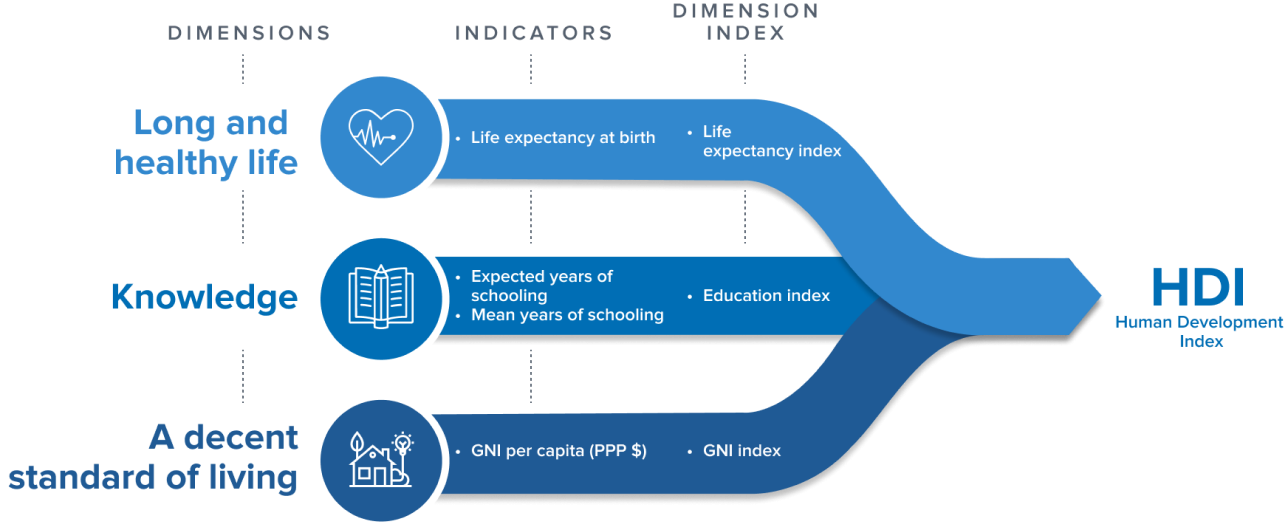- Home
- Prelims
- Mains
- Current Affairs
- Study Materials
- Test Series
 EDITORIALS & ARTICLES
EDITORIALS & ARTICLES
Disparities in Human Development Index (HDI)
- India is now one of the fastest-growing economies globally.
- However, this growth has not resulted in a corresponding increase in its Human Development Index (HDI).
Human Development Index (HDI)
- The HDI is a composite statistical measure created by the United Nations Development Programme.
- It aims to evaluate and compare the level of human development in different regions around the world.
- It was introduced in 1990 as an alternative to conventional economic measures such as Gross Domestic Product (GDP), which do not consider the broader aspects of human development.
- HDI scores range from 0 to 1, with higher values indicating higher levels of human development.
- The HDI assesses a country’s average accomplishment in three aspects: long and healthy life, knowledge, and a decent standard of living.
- India’s Rank: 132 out of 191 countries (2021-22).
- India is behind Bangladesh (129) and Sri Lanka (73).
How HDI is calculated?

- The HDI is calculated using four indicators:
- Life expectancy at birth,
- Mean years of schooling,
- Expected years of schooling, and
- Gross National Income (GNI) per capita
- Life expectancy estimates are taken from the Sample Registration System.
- Mean and expected years of schooling are extracted from National Family Health Survey-5.
- Estimates for GNI per capita are unavailable at the subnational level, gross state domestic product (GSDP) per capita is used as a proxy indicator to measure the standard of living.
How does the GSDP per capita is calculated?
- GSDP (PPP at constant prices 2011-12) is gathered from the Reserve Bank of India’s Handbook of Statistics on Indian States.
- GSDP per capita is estimated using the population projection provided by the Registrar General of India’s office.
- The methodology involves calculating the geometric mean of the normalized indices for the three dimensions of human development while applying the maximum and minimum values recommended by the UNDP and NSO.
About the subnational Human Development Index (HDI)
Subnational HDI
- A new index using the methodology suggested by the UNDP and the National Statistical Office (NSO) which measures human development on a subnational level for 2019-20.
- It will help India realize its demographic dividend.
Findings
- It shows that while some States have made considerable progress, others continue to struggle.
- Delhi occupies the top spot and Bihar occupies the bottom spot.
- Note: Bihar is no longer considered a low human development State.
- Five States with the highest HDI scores: Delhi, Goa, Kerala, Sikkim, and Chandigarh.
- Delhi and Goa have HDI scores above 0.799, which makes them equivalent to countries in Eastern Europe with a very high level of human development.
- 19 States have scores ranging between 0.7 and 0.799. It includes states like Kerala, Maharashtra, Tamil Nadu, Haryana, Punjab, Telangana, Gujarat, and Andhra Pradesh. They are classified as high human development States.
- Bottom five States: Bihar, Uttar Pradesh, Madhya Pradesh, Jharkhand, and Assam.
- This category also includes States such as Odisha, Rajasthan, and West Bengal, which have HDI scores below the national average.
- The scores of these low-performing States resemble those of African countries such as Congo, Kenya, Ghana, and Namibia.
- Gujarat and Haryana are ranked 21 and 10 despite the highest SGDP per capita among larger States.
- Kerala stands out with consistently high HDI values over the years, which can be attributed to its high literacy rates, robust healthcare infrastructure, and relatively high-income levels.
- Bihar has consistently held the lowest HDI value, with high poverty levels, low literacy rates, and poor healthcare infrastructure being the contributing factors.
- Note: The impact of COVID-19 on subnational HDI is not captured here.
Reasons for discrepancies
Economic growth
- It is unevenly distributed. The top 10% of the Indian population holds over 77% of the wealth.
- This has resulted in significant disparities in access to basic amenities, healthcare, and education.
Quality of Services
- India has made significant progress in reducing poverty and increasing access to healthcare and education. But the quality of the service remained low.
- Example: The country has achieved near-universal enrolment in primary education, but the quality of education remains low.
Key suggestions to improve human development
- Multi-faceted approach that addresses income inequality and gender inequality;
- Improves access to quality social services;
- Addresses environmental challenges; and
- Provides for greater investment in social infrastructure
- Social infrastructure includes healthcare, education, and basic household amenities including access to clean water, improved sanitation facility, clean fuel, electricity, and Internet in underdeveloped States.
The government must prioritize human development alongside economic growth to ensure that the benefits of growth are more evenly distributed. India should prioritize investments in human development and job creation, particularly for its youth.









 Latest News
Latest News General Studies
General Studies